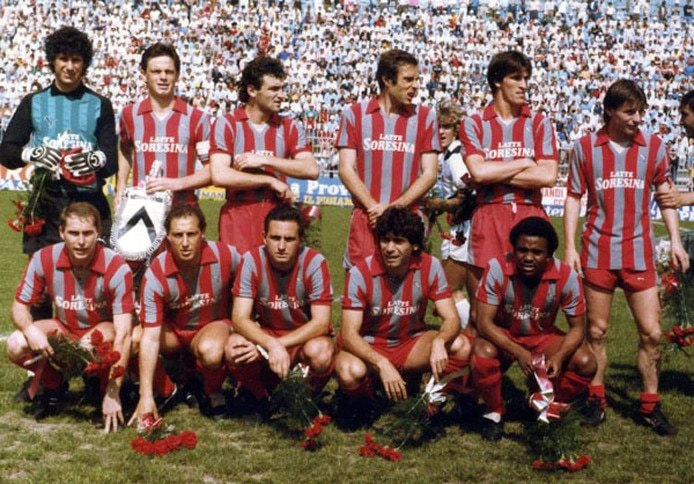READ ‘Champagne Cremonese: remembering the Grigiorossi’s Serie A debut
Following a dramatic and nerve-wracking 3-2 victory over Racing Roma on Saturday 6 May, Cremonese are back in Serie B after a 11-year hiatus.
For Calcio pundits and aficionados, their return to Italy’s second tier comes as welcome news. Formerly a Serie A club, Cremonese have a rich history; one that includes an Anglo-Italian Cup triumph at Wembley in 1993, and some well-known stars, most notably Antonio Cabrini, Gianluca Vialli, Władysław Żmuda, Anders Limpar, Attilio Lombardo and Enrico Chiesa.
The Lombardy based club have spent as many as seven seasons in Serie A, with their first dating back to 1984/85. As such, the season has a special place not just in the hearts of Calcio’ fans – renowned as the season when Hellas Verona were surprisingly crowned Italian champions – but also among the Grigiorossi’s fanbase.
The summer of 1984 was particularly interesting for football fans across the Peninsula. Serie A was entering into a Golden Age and Italian clubs were able to attract a number of standout players from abroad. The 5 July 1984 acted as a centerpiece of this influx. On this day, Napoli’s Stadio San Paolo registered its highest-ever gate receipts for a single event. This excitement was not fuelled by the prospect of seeing Napoli play, but rather a crowd of over 70,000 fans crammed into the San Paolo to see Diego Armando Maradona make his first public appearance as a Napoli footballer.
But El Diego wasn’t the only big name involved in the upcoming season. In fact, Juventus (the reigning champions) boasted Michel Platini and Zigbiew Boniek; Inter added German striker Karl-Heinz Rummenigge to the Irish midfielder Liam Brady; Torino signed Brazilian Leo Junior; Fiorentina increased their season tickets holders to 27,000 by securing the service of the Brazilian ‘Doctor Socrates’; whilst AC Milan lined up the British duo of Ray Wilkins and Mark Hateley.
With each team allowed just two foreign players and with Italian fans falling in love with their new and exotic foreign imports, Cremonese also approached their maiden Serie A campaign by attempting to bolster their squad with a couple of international players.
Thus, during the scorching summer of 1984, while Italian youngsters went crazy for pop hits such as Ci Vorrebbe Un Amico by Antonello Venditti and People From Ibiza by Sandy Marton, Cremonese’s president, Domenico Luzzara, and sporting director Erminio Favalli were busy in the transfer market. The fruits of their labour produced the signing of Brazilian Juary – a Serie A veteran who played with Avellino, Inter and Ascoli – and Polish international Wladyslaw Zmuda, who arrived from New York Cosmos.
Both players added some much need experience to the Cremonese squad, which contained the likes of defender Mario Montorfano, midfielder Fulvio Bonomi and forwards Gianluca Finardi, a baby-faced Vialli and Alviero Chiorri. Although it was Vialli who would shoot to stardom in the resultant years, it is worth mentioning that there were high hopes for Chiorri at the time, a player comparable to Antonio Cassano: i.e very talented but unable to show his full potential.
At the helm of this group was a young, vibrant and talented coach: Emiliano Mondonico.
A wasted talent during his playing days and a former Cremonese player himself, Mondonico was given the job in 1981. Under his tutelage, the Grigiorossi had become a strong Serie B side and had narrowly missed Serie A promotion during the 1982/83 season, losing a three-way playoff against Catania and Como.
Promotion, however, was postponed just one season, as Mondonico led Cremonese to the top tier the following campaign.
The Serie A newcomers made their debut on September 1984, facing Sampdoria away. Despite losing 1-0, the performance left much room for optimism, and the Grigiorossi would only have to wait one more week to celebrate their first Serie A victory. Hosting Serie A giants Torino at Stadio Giovanni Zini of Cremona, Mondonico opted for a starting XI that, funnily enough, featured neither of Cremonese’s foreign imports. Instead, it was an all-Italian line-up, including Borin; Montorfano, Galvani, Garzilli, Paolinelli, Mazzoni, Viganò, Bonomi, Nicoletti, Bencina and Chiorri. A penalty kick by Bonomi and a goal by Nicoletti sealed the 2-1 victory.
Unfortunately, that win was a rare high point in what was ultimately a troubled season. With a largely inexperienced team, Cremonese soon played their expected role of provincial minnows and were relegated at the end of the season with just 15 points.
The Grigiorossi’s summer signings had failed to contribute as expected. Juary scored twice in 19 appearances, while Zmuda made just 12 appearances after having his playing time curtailed by injuries. It was a poignant decline for Zmuda, who had first arrived on the peninsula in 1982 with great expectations, signed by Osvaldo Bagnoli at Verona. But the Polish international struggled to establish himself in the Verona defence, and though he tried to revive his career at Cremonese, his time in Italy proved his sunset boulevard. Meanwhile, the club’s relegation also led to the departure of rising star Vialli, who after being nurtured by Mondonico, earned a big move to Sampdoria.
Though Cremonese’s debut Serie A season ended in the disappointment of relegation, they were applauded for their entertaining style of play and Mondonico became one of the era’s iconic coaches, enjoying successful spells at Atalanta and Torino. The Grigiorossi themselves bounced back four years later, returning to Italy’s top flight in 1989.
Words by Michele Tossani: @MicheleTossani
‘Michele Tossani is a tactical analyst for Spielverlagerung, Rivista Undici, Futbol Tactico and many others.’

